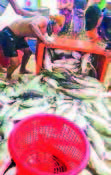MYANMAR earned more than US$722 million from over 550,000 tonnes of freshwater exports in the 2024-2025 financial year, according to the Myanmar Fisheries Federation.
“To double export production, livestock business operators need to make efforts to produce value-added products. It is necessary to change from traditional sales methods to new approaches. If aquatic products can be produced as ready-to-eat or ready-to-cook items alongside aquaculture, it will help increase foreign incomes. We export rohu, catla catla and ilish annually. In the 2024-2025 financial year, we received over US$ 722 million from freshwater product exports, and we now make efforts to increase the export volumes in the 2025-2026 financial year,” said Dr Toe Nanda Tin, senior vice president of the Myanmar Fisheries Federation.
Myanmar mainly exports rohu, catla catla, ilish and other fish to India, Bangladesh, Saudi Arabia and other countries. The freshwater products are produced in Ayeyawady, Yangon and Bago regions. This year, the freshwater products are being transported to the local market and also exported to foreign countries, depending on the size. The fish farmers breed the fish the whole year round.
“For exports, the people breed and export depending on the sizes and ponds. Currently, we breed rohu weighing between one viss and thirty ticals and over six visses and catla catla weighing over eight visses. For export, we carefully feed the fish and breed from 700 to 1000 fingerlings per acre. We farm up to 1200 fish. The methods are different from the Vietnamese fish farming method. We have to be more careful as we farm the large-sized fish. The fish prices are good now locally and also for export. The fish ponds were flooded last year, and we have to be aware of this during this monsoon. We also make efforts to ensure local consumption and exports for foreign income. Although we face difficulties with the prices of feed, we try hard using various ways,” said U Kyaw Kyaw from Nyaungdon in Ayeyawady Region.
The Fisheries Department and Myanmar Fisheries Federation make efforts to produce quality products, while other countries practise GAqP to BAP. — Nyein Thu (MNA)/ KTZH


